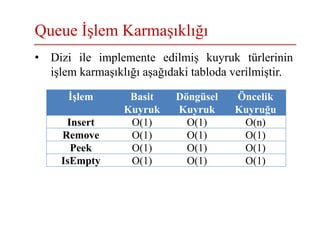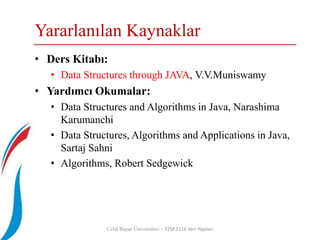Yzm 2116 - B├Čl├╝m 5 (Queue, Kuyruk, Basit, Dairesel, ├¢ncelikli)
- 1. YZM 2116 Veri Yap─▒lar─▒ Yrd. Do├¦. Dr. Deniz KILIN├ć Celal Bayar ├£niversitesi Hasan Ferdi Turgutlu Teknoloji Fak├╝ltesi Yaz─▒l─▒m M├╝hendisli─¤i
- 2. B├¢L├£M - 5 Bu b├Čl├╝mde, ŌĆó Kuyruk VY ve ADT ŌĆó Basit Kuyruk (Simple Queue) ŌĆó D├Čng├╝sel Kuyruk (Circular Queue) ŌĆó ├¢ncelik Kuyru─¤u (Priority Queue) konusuna de─¤inilecektir. Celal Bayar ├£niversitesi ŌĆō YZM 2116 Veri Yap─▒lar─▒
- 3. Kuyruk Giri┼¤ ŌĆó Kuyruk, eleman eklemelerin sondan (rear) ve eleman ├¦─▒karmalar─▒n bastan (front) yap─▒ld─▒─¤─▒, (First In First Out- ─░lk Gelen ─░lk ├ć─▒kar ŌĆō FIFO) olarak modellenen, do─¤rusal bir veri saklama yap─▒s─▒d─▒r. ŌĆó Bir eleman─▒n kuyru─¤a girmesi insert (literat├╝rde put, add veya enqueue olarak da ge├¦er) i┼¤lemi iken listeden silinmesi remove (delete veya dequeue) i┼¤lemidir. ŌĆó InsertŌĆÖler kuyru─¤un arkas─▒ndan yap─▒l─▒rken, removeŌĆÖlar kuyru─¤un ├Čn├╝nden yap─▒l─▒rlar. ŌĆó Bo┼¤ bir kuyruktan eleman silmeye ├¦al─▒┼¤mak underflow hatas─▒ ├╝retirken, dolu bir kuyru─¤a eleman eklemeye ├¦al─▒┼¤mak overflow hatas─▒ ├╝retir. Celal Bayar ├£niversitesi ŌĆō YZM 2116 Veri Yap─▒lar─▒
- 4. Kuyruk Giri┼¤ (devamŌĆ”) Celal Bayar ├£niversitesi ŌĆō YZM 2116 Veri Yap─▒lar─▒ ŌĆó Kuyruk yap─▒s─▒, y─▒─¤─▒n yap─▒s─▒na olduk├¦a benzemektedir. ─░kisinde de eleman ekleme i┼¤lemi en sondan yap─▒lmaktad─▒r. ŌĆó Aralar─▒ndaki fark eleman ├¦─▒kartman─▒n y─▒─¤─▒n yap─▒s─▒nda en sondan, kuyruk yap─▒s─▒nda ise en ba┼¤tan yap─▒lmas─▒d─▒r.
- 5. Kuyruk ADT Celal Bayar ├£niversitesi ŌĆō YZM 2116 Veri Yap─▒lar─▒ Insert(obj) Kuyru─¤un sonuna (rear) eleman ekler. obj Remove() Kuyru─¤un ├Čn├╝ndeki (front) ilk eleman─▒ yani i┼¤i biten eleman─▒ siler. Kuyruk bo┼¤sa hata d├Čner. obj Peek() Kuyru─¤un ├Čn├╝ndeki (front) eleman─▒ geriye d├Čnd├╝r├╝r. bool IsEmpty() Kuyruk bo┼¤sa true de─¤ilse false d├Čner. public interface IQueue { void Insert(object o); object Remove(); object Peek(); Boolean IsEmpty(); }
- 6. Kuyruk Dizi Ger├¦ekle┼¤tirim Celal Bayar ├£niversitesi ŌĆō YZM 2116 Veri Yap─▒lar─▒ Queue dizi implementasyonu i├¦in kurallar ŌĆó Queue dizi implemetasyonunda dizimizi queue[n] olarak tan─▒mlarsak, o n kuyruktaki maksimum eleman say─▒s─▒d─▒r. ŌĆó Implementasyonda front ve rear olmak ├╝zere 2 tane de─¤i┼¤ken tan─▒mlan─▒r. o front: kuyru─¤un ├Čn├╝ndeki eleman─▒ temsil eder. ’é¦ front = -1 ise kuyruk bo┼¤tur. ’é¦ Kuyruktan her eleman ├¦─▒kart─▒ld─▒─¤─▒nda (REMOVE) front bir artar. o rear: kuyru─¤un sonundaki eleman─▒ temsil eder. ’é¦ Kuyru─¤a her eleman eklendi─¤inde (INSERT) rear bir artar.
- 7. Celal Bayar ├£niversitesi ŌĆō YZM 2116 Veri Yap─▒lar─▒ front ve rear ŌĆó Kuyru─¤a bir eleman eklenince ne olur? ŌĆó Kuyruktan bir eleman ├¦─▒kart─▒l─▒nca (i┼¤i bitince ne olur?) Kuyruk Dizi Ger├¦ekle┼¤tirim (devamŌĆ”)
- 8. Kuyruk Dizi Ger├¦ekle┼¤tirim (devamŌĆ”) Celal Bayar ├£niversitesi ŌĆō YZM 2116 Veri Yap─▒lar─▒ Insert(333) Delete() ----------------------------------------------------------------------------------------- -----------------------------------------------------------------------------------------
- 9. Kuyruk Dizi Ger├¦ekle┼¤tirim (devamŌĆ”) Celal Bayar ├£niversitesi ŌĆō YZM 2116 Veri Yap─▒lar─▒ ├¢RNEK 2:
- 10. Kuyruk Dizi Ger├¦ekle┼¤tirim (devamŌĆ”) Celal Bayar ├£niversitesi ŌĆō YZM 2116 Veri Yap─▒lar─▒ ├¢RNEK 2: F i├¦in yer kalmad─▒ !!! 2 elemanl─▒k alan kullan─▒lamaz hale geldi !!!
- 11. Simple Queue Celal Bayar ├£niversitesi ŌĆō YZM 2116 Veri Yap─▒lar─▒ ŌĆó Simple Queue (basit kuyruk) olarak adland─▒r─▒lan bu kuyruk tipi o hep ileri y├Čnde hareket etmekte ve o verimsiz alan kullan─▒m─▒na neden olmaktad─▒r.
- 12. Simple Queue Kaynak Kod Celal Bayar ├£niversitesi ŌĆō YZM 2116 Veri Yap─▒lar─▒ //S─▒n─▒f Tan─▒m─▒ public class SimpleArrayTypedQueue: IQueue //├£ye De─¤i┼¤kenleri private object[] Queue; private int front = -1; private int rear = -1; private int size = 0; private int count = 0; //Constructor public SimpleArrayTypedQueue(int size) { this.size = size; Queue = new object[size]; }
- 13. Simple Queue Kaynak Kod (devamŌĆ”) Celal Bayar ├£niversitesi ŌĆō YZM 2116 Veri Yap─▒lar─▒ public void Insert(object o) { if ((count == size) || (rear == size -1)) throw new Exception("Queue dolu."); if (front == -1) front = 0; Queue[++rear] = o; count++; }
- 14. Simple Queue Kaynak Kod (devamŌĆ”) Celal Bayar ├£niversitesi ŌĆō YZM 2116 Veri Yap─▒lar─▒ public object Remove() { if (IsEmpty()) throw new Exception("Queue bo┼¤."); object temp = Queue[front]; Queue[front] = null; front++; count--; return temp; } public bool IsEmpty() { return (count == 0); }
- 15. Simple Queue ─░yile┼¤tirmeler Celal Bayar ├£niversitesi ŌĆō YZM 2116 Veri Yap─▒lar─▒ Basit kuyruk ger├¦ekle┼¤tiriminde ├¦e┼¤itli iyile┼¤tirmeler yap─▒labilir: ’éĘ ─░yile┼¤tirme 1: Silme sonucunda kuyrukta hi├¦ eleman kalmazsa, kuyruk s─▒f─▒rdan olu┼¤turulmu┼¤ gibi ilk durumuna getirilebilir. ’éĘ ─░yile┼¤tirme 2: Kayd─▒rma (shift) i┼¤lemi yap─▒larak ├Čndeki bo┼¤ yerler kullan─▒ma sokulmak ├╝zere arkaya ta┼¤─▒nabilir, fakat kayd─▒rmalar a┼¤─▒r─▒ zaman al─▒r ve maliyetlidir. ’éĘ ─░yile┼¤tirme 3: Di─¤er iyile┼¤tirme kuyru─¤un bo┼¤ta kalan ├Čndeki alanlar─▒n─▒ kullanmaya y├Čnelik bir geli┼¤tirme yap─▒labilir (Circular - D├Čng├╝sel Kuyruk).
- 16. Circular Queue Celal Bayar ├£niversitesi ŌĆō YZM 2116 Veri Yap─▒lar─▒ ŌĆó Basit kuyrukta kar┼¤─▒la┼¤─▒lan ve kuyru─¤un ba┼¤─▒nda kalan kullan─▒lamayan alan problemini ├¦├Čzmek i├¦in d├Čng├╝sel kuyruk veri yap─▒s─▒ geli┼¤tirilmi┼¤tir. ŌĆó D├Čng├╝sel kuyrukta, o Kuyru─¤un ba┼¤─▒ ile sonu birle┼¤tirilmi┼¤tir. ŌĆó ├¢nde bo┼¤alan yerler, arkadaym─▒┼¤ gibi otomatik olarak kullan─▒ma sokulur.
- 17. D├Čng├╝sel Kuyruk Dizi Ger├¦ekle┼¤tirim Celal Bayar ├£niversitesi ŌĆō YZM 2116 Veri Yap─▒lar─▒ ├¢RNEK 3:
- 18. Celal Bayar ├£niversitesi ŌĆō YZM 2116 Veri Yap─▒lar─▒ ├¢RNEK 3: D├Čng├╝sel Kuyruk Dizi Ger├¦ekle┼¤tirim (devamŌĆ”)
- 19. Celal Bayar ├£niversitesi ŌĆō YZM 2116 Veri Yap─▒lar─▒ ├¢RNEK 3: D├Čng├╝sel Kuyruk Dizi Ger├¦ekle┼¤tirim (devamŌĆ”)
- 20. Celal Bayar ├£niversitesi ŌĆō YZM 2116 Veri Yap─▒lar─▒ ├¢RNEK 3: Ad─▒m 6 sonras─▒nda olu┼¤an son durumun d├Čng├╝sel kuyruk ile g├Čsterimi a┼¤a─¤─▒daki gibidir: D├Čng├╝sel Kuyruk Dizi Ger├¦ekle┼¤tirim (devamŌĆ”)
- 21. D├Čng├╝sel Kuyruk Kaynak Kod (devamŌĆ”) Celal Bayar ├£niversitesi ŌĆō YZM 2116 Veri Yap─▒lar─▒ public void Insert(object o) { if ((count == size) || (rear == size -1)) throw new Exception("Queue dolu."); if (front == -1) front = 0; //Circular Code De─¤i┼¤ikli─¤i if (rear == size - 1) { rear = 0; Queue[rear] = o; } else Queue[++rear] = o; count++; }
- 22. D├Čng├╝sel Kuyruk Kaynak Kod (devamŌĆ”) Celal Bayar ├£niversitesi ŌĆō YZM 2116 Veri Yap─▒lar─▒ public object Remove() { if (IsEmpty()) throw new Exception("Queue bo┼¤."); object temp = Queue[front]; Queue[front] = null; //Circular Code De─¤i┼¤ikli─¤i if (front == size - 1) front = 0; else front++; count--; return temp; } public bool IsEmpty() { return (count == 0); }
- 23. Priority Queue Celal Bayar ├£niversitesi ŌĆō YZM 2116 Veri Yap─▒lar─▒ ŌĆó Standart kuyruk veri yap─▒s─▒ ├Čnceliklendirme eksikli─¤i nedeniyle, bir├¦ok durumda (problemde) kullan─▒lmak i├¦in uygun olmayabilir. ŌĆó Ger├¦ek hayatta uygulanan kuyruk yap─▒lar─▒nda ├Čncelik durumu dikkate al─▒n─▒r, ├Čnceli─¤i y├╝ksek olanlar ├Čnce i┼¤lem g├Čr├╝rler.
- 24. Priority Queue (devamŌĆ”) Celal Bayar ├£niversitesi ŌĆō YZM 2116 Veri Yap─▒lar─▒ ŌĆó ├¢rne─¤in; yaz─▒l─▒m bak─▒m s├╝recinde yaz─▒l─▒m departman─▒na iletilen hatalar─▒ d├╝┼¤├╝nelim. ─░letilen her hata bir havuza at─▒l─▒r ve s─▒ras─▒yla uygun yaz─▒l─▒mc─▒ya iletilir. Baz─▒ hatalar di─¤erlerinden daha ├Čnceliklidir. ŌĆó Mesela sistemdeki t├╝m mod├╝lleri etkileyen hatalar ├¦ok daha kritik olup di─¤erlerinden daha ├Čnce tamamlanmal─▒d─▒r. ŌĆó Ayn─▒ ┼¤ekilde i┼¤letim sistemlerinde baz─▒ prosesler di─¤erlerinden daha ├Čncelikli olarak ├¦al─▒┼¤mak durumundad─▒r.
- 25. Priority Queue (devamŌĆ”) Celal Bayar ├£niversitesi ŌĆō YZM 2116 Veri Yap─▒lar─▒ ŌĆó ├¢ncelik kuyruklar─▒, ŌĆó artan ve azalan olmak ├╝zere ikiye ayr─▒l─▒rlar. ŌĆó Di─¤er veri yap─▒lar─▒nda oldu─¤u gibi kuyrukta bulunan elemanlar, string veya integer gibi basit veri t├╝r├╝nde olabilece─¤i gibi ├Čzelliklere (attribute) sahip bir nesne de olabilir. ŌĆó ├¢ncelik kriterinin ne olaca─¤─▒ kuyruktan kuyru─¤a de─¤i┼¤kenlik g├Čsterir. ŌĆó Kuyru─¤a eklenen eleman─▒n kendisi veya herhangi bir ├Čzelli─¤i, ├Čncelik kriteri olabilir.
- 26. Priority Queue (devamŌĆ”) Celal Bayar ├£niversitesi ŌĆō YZM 2116 Veri Yap─▒lar─▒ ŌĆó ├¢rne─¤in; telefon rehberi uygulamas─▒nda, ŌĆó Kuyruktaki her eleman soyad, ad, adres ve telefon numaras─▒ ├Čzelliklerinden olu┼¤makta ve kuyruk soyada g├Čre s─▒ralanmaktad─▒r. ŌĆó ├¢ncelik kuyruklar─▒; ŌĆó Dizi, ŌĆó Ba─¤l─▒ Liste ŌĆó Binary Heap kullan─▒larak implemente edilebilir.
- 27. PQ Dizi Ger├¦ekle┼¤tirim Celal Bayar ├£niversitesi ŌĆō YZM 2116 Veri Yap─▒lar─▒ ŌĆó Artan tipteki ├Čncelik kuyru─¤unda en k├╝├¦├╝k de─¤ere sahip eleman en ├Čncelikli olarak kuyruktan silinir (yani ilk olarak i┼¤lem g├Čr├╝r). ├¢RNEK 4:
- 28. PQ Dizi Ger├¦ekle┼¤tirim (devamŌĆ”) Celal Bayar ├£niversitesi ŌĆō YZM 2116 Veri Yap─▒lar─▒ ├¢RNEK 4:
- 29. PQ Dizi Ger├¦ekle┼¤tirim (devamŌĆ”) Celal Bayar ├£niversitesi ŌĆō YZM 2116 Veri Yap─▒lar─▒ ├¢RNEK 4:
- 30. PQ Dizi Ger├¦ekle┼¤tirim (devamŌĆ”) Celal Bayar ├£niversitesi ŌĆō YZM 2116 Veri Yap─▒lar─▒ ├¢RNEK 4:
- 31. Priority Queue Kaynak Kod Celal Bayar ├£niversitesi ŌĆō YZM 2116 Veri Yap─▒lar─▒ public class PriorityQueue: IQueue private object[] Queue; private int front = -1; //Not1: rear de─¤eri hep 0 oldu─¤u i├¦in de─¤i┼¤mez. //Not2: size ve count de─¤i┼¤kenlerinden birisi //istenirse kullan─▒lmayabilir private int size = 0; private int count = 0; public PriorityQueue(int size) { this.size = size; Queue = new object[size]; }
- 32. Priority Queue Kaynak Kod (devamŌĆ”) public void Insert(object o) { if (count == size) throw new Exception("Queue is full"); if (IsEmpty()) { front++; Queue[front] = o; } else { int i; //Not3: //Son elemandan ba┼¤layarak geriye do─¤ru kuyruk kontrol ediliyor //Eklenecek eleman─▒n pozisyonu belirleniyor //Var olan elemanlar kayd─▒r─▒l─▒yor for (i = count - 1; i >= 0; i--) { if ((int)o > (int)Queue[i]) Queue[i + 1] = Queue[i]; else break; } Queue[i + 1] = o; front++; } count++; }
- 33. Priority Queue Kaynak Kod (devamŌĆ”) public object Remove() { if (this.IsEmpty()) { throw new Exception("Queue is empty..."); } object temp = Queue[front]; Queue[front] = null; front--; count--; return temp; }
- 34. Queue ─░┼¤lem Karma┼¤─▒kl─▒─¤─▒ ─░┼¤lem Basit Kuyruk D├Čng├╝sel Kuyruk ├¢ncelik Kuyru─¤u Insert O(1) O(1) O(n) Remove O(1) O(1) O(1) Peek O(1) O(1) O(1) IsEmpty O(1) O(1) O(1) ŌĆó Dizi ile implemente edilmi┼¤ kuyruk t├╝rlerinin i┼¤lem karma┼¤─▒kl─▒─¤─▒ a┼¤a─¤─▒daki tabloda verilmi┼¤tir.
- 35. ─░Y─░ ├ćALI┼×MALARŌĆ” Celal Bayar ├£niversitesi ŌĆō YZM 2116 Veri Yap─▒lar─▒
- 36. Yararlan─▒lan Kaynaklar ŌĆó Ders Kitab─▒: ŌĆó Data Structures through JAVA, V.V.Muniswamy ŌĆó Yard─▒mc─▒ Okumalar: ŌĆó Data Structures and Algorithms in Java, Narashima Karumanchi ŌĆó Data Structures, Algorithms and Applications in Java, Sartaj Sahni ŌĆó Algorithms, Robert Sedgewick Celal Bayar ├£niversitesi ŌĆō YZM 2116 Veri Yap─▒lar─▒


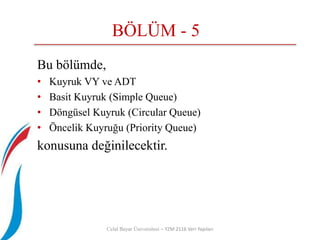

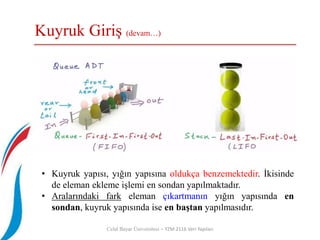
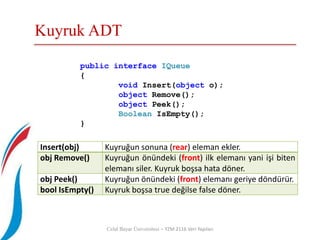
![Kuyruk Dizi Ger├¦ekle┼¤tirim
Celal Bayar ├£niversitesi ŌĆō YZM 2116 Veri Yap─▒lar─▒
Queue dizi implementasyonu i├¦in kurallar
ŌĆó Queue dizi implemetasyonunda dizimizi queue[n] olarak
tan─▒mlarsak,
o n kuyruktaki maksimum eleman say─▒s─▒d─▒r.
ŌĆó Implementasyonda front ve rear olmak ├╝zere 2 tane de─¤i┼¤ken
tan─▒mlan─▒r.
o front: kuyru─¤un ├Čn├╝ndeki eleman─▒ temsil eder.
’é¦ front = -1 ise kuyruk bo┼¤tur.
’é¦ Kuyruktan her eleman ├¦─▒kart─▒ld─▒─¤─▒nda (REMOVE) front bir
artar.
o rear: kuyru─¤un sonundaki eleman─▒ temsil eder.
’é¦ Kuyru─¤a her eleman eklendi─¤inde (INSERT) rear bir artar.](https://image.slidesharecdn.com/yzm2116-blm5-queue-160314194045/85/Yzm-2116-Bolum-5-Queue-Kuyruk-Basit-Dairesel-Oncelikli-6-320.jpg)
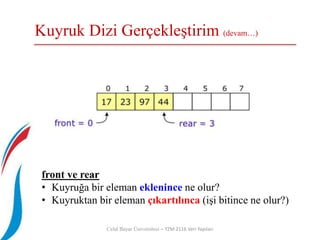
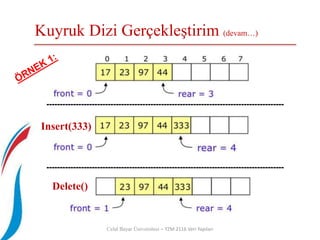
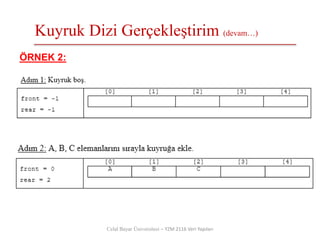
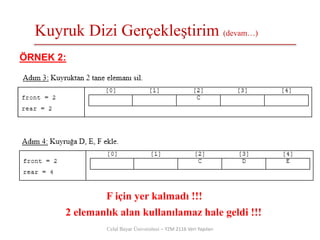

![Simple Queue Kaynak Kod
Celal Bayar ├£niversitesi ŌĆō YZM 2116 Veri Yap─▒lar─▒
//S─▒n─▒f Tan─▒m─▒
public class SimpleArrayTypedQueue: IQueue
//├£ye De─¤i┼¤kenleri
private object[] Queue;
private int front = -1;
private int rear = -1;
private int size = 0;
private int count = 0;
//Constructor
public SimpleArrayTypedQueue(int size)
{
this.size = size;
Queue = new object[size];
}](https://image.slidesharecdn.com/yzm2116-blm5-queue-160314194045/85/Yzm-2116-Bolum-5-Queue-Kuyruk-Basit-Dairesel-Oncelikli-12-320.jpg)
![Simple Queue Kaynak Kod (devamŌĆ”)
Celal Bayar ├£niversitesi ŌĆō YZM 2116 Veri Yap─▒lar─▒
public void Insert(object o)
{
if ((count == size) || (rear == size -1))
throw new Exception("Queue dolu.");
if (front == -1)
front = 0;
Queue[++rear] = o;
count++;
}](https://image.slidesharecdn.com/yzm2116-blm5-queue-160314194045/85/Yzm-2116-Bolum-5-Queue-Kuyruk-Basit-Dairesel-Oncelikli-13-320.jpg)
![Simple Queue Kaynak Kod (devamŌĆ”)
Celal Bayar ├£niversitesi ŌĆō YZM 2116 Veri Yap─▒lar─▒
public object Remove()
{
if (IsEmpty())
throw new Exception("Queue bo┼¤.");
object temp = Queue[front];
Queue[front] = null;
front++;
count--;
return temp;
}
public bool IsEmpty()
{
return (count == 0);
}](https://image.slidesharecdn.com/yzm2116-blm5-queue-160314194045/85/Yzm-2116-Bolum-5-Queue-Kuyruk-Basit-Dairesel-Oncelikli-14-320.jpg)
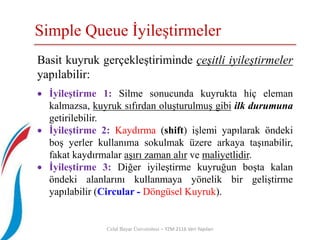
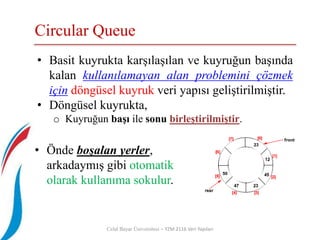

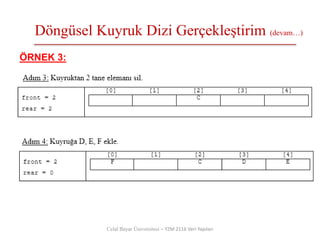

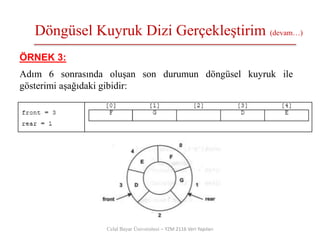
![D├Čng├╝sel Kuyruk Kaynak Kod (devamŌĆ”)
Celal Bayar ├£niversitesi ŌĆō YZM 2116 Veri Yap─▒lar─▒
public void Insert(object o)
{
if ((count == size) || (rear == size -1))
throw new Exception("Queue dolu.");
if (front == -1)
front = 0;
//Circular Code De─¤i┼¤ikli─¤i
if (rear == size - 1)
{
rear = 0;
Queue[rear] = o;
}
else
Queue[++rear] = o;
count++;
}](https://image.slidesharecdn.com/yzm2116-blm5-queue-160314194045/85/Yzm-2116-Bolum-5-Queue-Kuyruk-Basit-Dairesel-Oncelikli-21-320.jpg)
![D├Čng├╝sel Kuyruk Kaynak Kod (devamŌĆ”)
Celal Bayar ├£niversitesi ŌĆō YZM 2116 Veri Yap─▒lar─▒
public object Remove()
{
if (IsEmpty())
throw new Exception("Queue bo┼¤.");
object temp = Queue[front];
Queue[front] = null;
//Circular Code De─¤i┼¤ikli─¤i
if (front == size - 1)
front = 0;
else
front++;
count--;
return temp;
}
public bool IsEmpty()
{
return (count == 0);
}](https://image.slidesharecdn.com/yzm2116-blm5-queue-160314194045/85/Yzm-2116-Bolum-5-Queue-Kuyruk-Basit-Dairesel-Oncelikli-22-320.jpg)

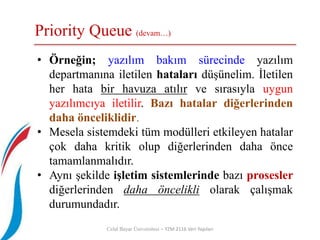
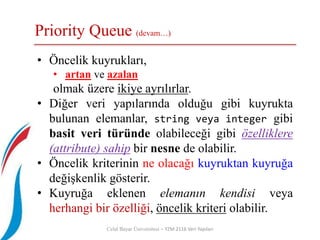

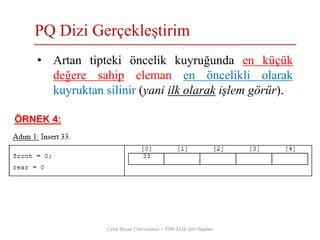
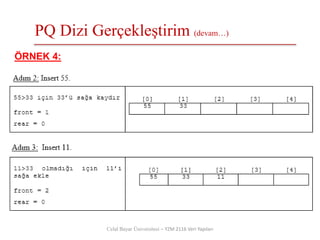
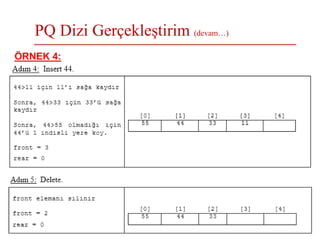
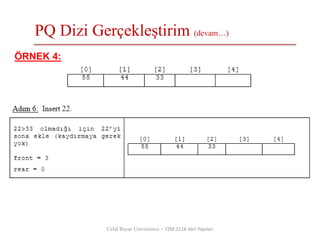
![Priority Queue Kaynak Kod
Celal Bayar ├£niversitesi ŌĆō YZM 2116 Veri Yap─▒lar─▒
public class PriorityQueue: IQueue
private object[] Queue;
private int front = -1;
//Not1: rear de─¤eri hep 0 oldu─¤u i├¦in de─¤i┼¤mez.
//Not2: size ve count de─¤i┼¤kenlerinden birisi
//istenirse kullan─▒lmayabilir
private int size = 0;
private int count = 0;
public PriorityQueue(int size)
{
this.size = size;
Queue = new object[size];
}](https://image.slidesharecdn.com/yzm2116-blm5-queue-160314194045/85/Yzm-2116-Bolum-5-Queue-Kuyruk-Basit-Dairesel-Oncelikli-31-320.jpg)
![Priority Queue Kaynak Kod (devamŌĆ”)
public void Insert(object o)
{
if (count == size)
throw new Exception("Queue is full");
if (IsEmpty())
{
front++;
Queue[front] = o;
}
else
{
int i;
//Not3:
//Son elemandan ba┼¤layarak geriye do─¤ru kuyruk kontrol ediliyor
//Eklenecek eleman─▒n pozisyonu belirleniyor
//Var olan elemanlar kayd─▒r─▒l─▒yor
for (i = count - 1; i >= 0; i--)
{
if ((int)o > (int)Queue[i])
Queue[i + 1] = Queue[i];
else
break;
}
Queue[i + 1] = o;
front++;
}
count++;
}](https://image.slidesharecdn.com/yzm2116-blm5-queue-160314194045/85/Yzm-2116-Bolum-5-Queue-Kuyruk-Basit-Dairesel-Oncelikli-32-320.jpg)
![Priority Queue Kaynak Kod (devamŌĆ”)
public object Remove()
{
if (this.IsEmpty())
{
throw new Exception("Queue is empty...");
}
object temp = Queue[front];
Queue[front] = null;
front--;
count--;
return temp;
}](https://image.slidesharecdn.com/yzm2116-blm5-queue-160314194045/85/Yzm-2116-Bolum-5-Queue-Kuyruk-Basit-Dairesel-Oncelikli-33-320.jpg)
